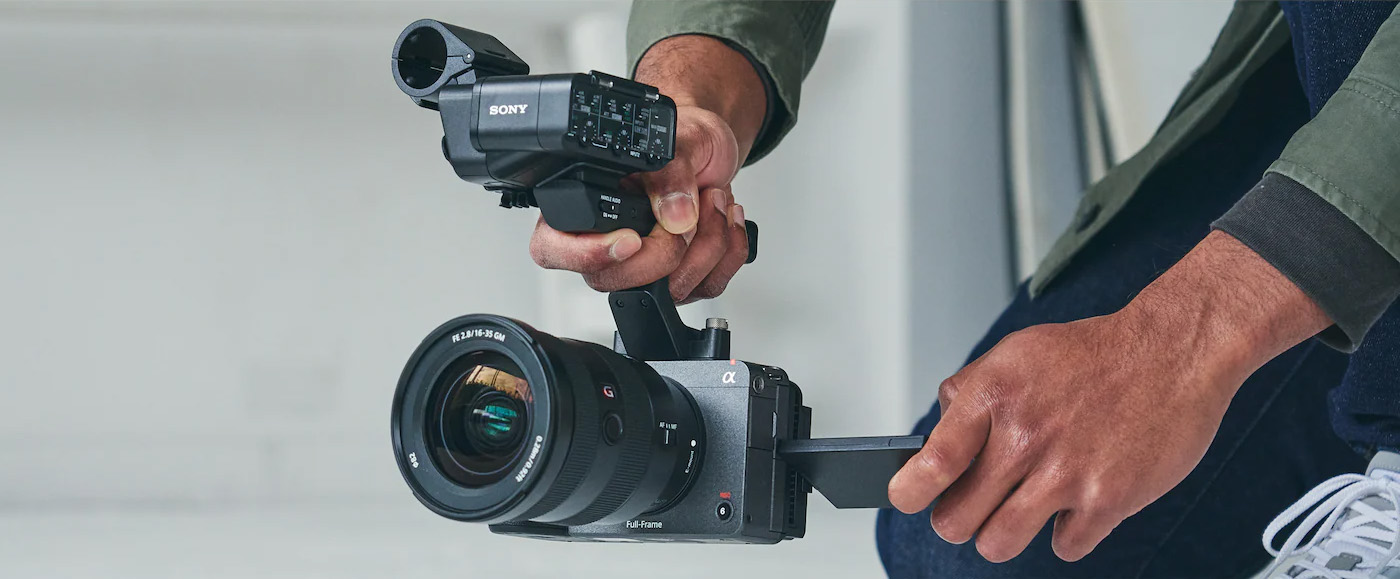The Sony FX3 is a high-end, professional video camera that has been designed to provide videographers with the highest level of quality and performance in a single package. Offering superior image quality, low light sensitivity and advanced ergonomics for comfortable shooting, it’s our camera of choice when shooting corporate video, live events, advertising, video for social media & YouTube™.
Is it expensive? Absolutely! But there are a number of reasons why we chose to invest in multple FX3’s and we’d like to share those with you here.
What are some of the cheaper alternatives to the FX3?
If you are looking to save money, there are certainly some great options out there that can produce pretty good results without breaking your budget.
Unfortunately, they don’t come close to offering the same kind of quality or performance that comes with the Sony FX3. While many will include complicated acronyms and suprisingly impressive capabilities for the price, don’t be fooled into thinking “8K” is better than “4K”.
The problem with technology is, you can’t always tell the difference straight away.
Sure, you might think that higher resolution equals better quality, but what’s the point of all those pixels if you can’t see what’s happening because it’s too dark? What happens if you get asked to do some super slow-motion footage at the current standard of 4K? And how well will your camera track a subject in a hi-speed action scene?
If you don’t have all the tools you need to when the action starts rolling, “8K” simply ‘aint going to help.
Canon EOS R5
The Canon EOS R5 is a great example; this DSLR Camera body comes equipped with 8K 30p internal recording capability along with great low-light sensitivity and powerful auto focus making it an ideal mid-level option between pro equipment like the Sony FX3 and hobbyist cameras like those from GoPro or DJI Mavic Air 2 series drones. While it does come at a premium price (in it’s class) it pales in comparison to what you would pay for an FX3.
Panasonic GH Series
Another more affordable solution could be found by looking at mirrorless cameras from Japanese manufacturer Panasonic; their GH series offers superb image quality thanks in part to their large sensor size along with 4K 60fps UHD internal recording capabilities. This is all packaged into a camera body costing significantly less than many entry-level broadcast camcorders.
Sony A7SIII
The Sony FX3 and the Sony A7S II are two of the most popular cameras in the Sony lineup. On face value, both cameras offer excellent image quality and features, and some very similar specifications but there are a few key differences that set them apart.
Both cameras make use of a 12MP+ full-frame CMOS sensor, BIONZ X image processor and both have a maximum ISO of 409,600 with the ability to shoot up to 120fps in 4K, both have similar lens mounting options and both come with a 5-axis in-body image stabilization system and a fast hybrid autofocus system.
When you look at them head to head, it’s easy to conclude that they have much more in common than most cameras, so what are the differences?
It might not seem significant at first, but the the FX3 uses a 12.1MP Exmor R CMOS sensor, while the Sony A7SIII uses the stock 12.2MP Exmor CMOS sensor. The Exmor R sensor is actually designed to be more sensitive to light, even though it comes in with fewer megapixels, allowing for better low-light performance. On the flipside, the higher megapixel count allows the A7SIII to provide slightly higher resolution for stills.
Due to the FX3 being part of Sony’s Cinema-Line range of products, the FX3 also comes with XLR ports built into the handle. This is important for those wanting the benefits that XLR provide like professional audio connections. And while we’re talking about connectivity & flexibility, the FX3 also comes with a variety of thread holes for rigging out the camera with rails, handles, mounts, monitors and other professional addons. Something to keep in mind if you’re after a mor professional device that can be added to over time.
The FX3 also comes with active cooling fans, something that’s missing in the A7SIII. This means that shooting high frame-rate, high-resolution video won’t cause the camera to overheat when performing extended shoots, something that’s a common problem among cameras in this class.
Blackmagic URSA Pro Mini
The technology being developed by Blackmagic Design is formidable. Not only are they taking great strides in next generation software & accessories, their cameras are making videographers stand up and take notice. The URSA Mini Pro 4.6k g2 is no exception. So let’s compare it with the Sony.
The FX3 features a full–frame 12.1MP Exmor R CMOS sensor, while the URSA Mini Pro has a 4.6K Super 35mm CMOS sensor. Lot’s of acronyms there, but in a nutshell, the larger sensor on the FX3 allows for more detail and better low–light performance, while the smaller sensor on the Blackmagic URSA Mini Pro 4.6k g2 allows for a more shallow depth of field.
The FX3 also sports an E-mount lens mount, compatible with a wide range of lenses. The URSA Mini Pro on the other hand, has a PL mount, which is more commonly used for cinema lenses & is a little more restrictive, especially if you want to buy (or sell) lenses in the second hand market. It should also be said that Sony lens technology seems to work best with their own cameras (gee, really?) and there are some very compelling reasons to be using Sony lenses. Lens-based stabilisation is one good example of where Sony is leading the pack here and there’s some pretty good anectdotal evidence that motion tracking and face recognition simply work better with native lenses on the Sony’s, another area where they show significant superiority.
The URSA Mini Pro can record in ProRes and DNxHD formats, however the FX3 uses a variety of proprietary formats XAVC-I, XAVC-L, and XAVC-S which can be a bit limiting as the XAVC formats consume significantly more storage space. The use of an external monitor, however, changes this completely and quite a common scenario for most videographers, so depending on your setup, these limitations may not even be a factor.
The FX3 also has the ability to record in 4K at up to 120fps, while the Blackmagic can only record in 4K at up to 60fps. This is significant, especially if you use slow-motion quite a bit for cinematic reasons.
The URSA Mini has a dynamic range of 13 stops, compared to the FX3’s 15 stops meaning that the Sony can capture more detail in both the shadows and highlights.
GoPro Hero
Action cams are all the rage lately. These smaller devices offer amazing value considering how little they cost. Obviously, they do so at the expense of certain features, like having limited control over some settings (due to the small form factor). This tends to restrict their use to more specific tasks like underwater diving, skateboarding, skydiving or mountain biking.
They typically excel because their rugged construction minimises conerns over damage. They also offer excellent image stabilization for hi-speed action video, and overall, image quality has come a long way, with video capture exceeding 5K and frame rates exceeding 100fps (at 4K).
Realistically though? They’re a great accessory for adventurists, bloggers & extreme sports because they won’t break the bank and they are really good, but a serious comparison simply isn’t warranted here as they’re just not in the same class as the FX3.
What options are there for cameras in the same class as the FX3?
Ok, so what are the features of the FX3 and why is it so good?
It also features an impressive array of features such as 4K recording, slow motion capture up to 120 fps, advanced autofocus capabilities and dual media slots for simultaneous recording on two different cards. With its extensive list of benefits and extensive price tag jutting into five figures it’s certainly not the first choice for many when shopping around for a video camera.
When it comes to professional film and video production, filmmakers are often faced with the challenge of finding a camera that can deliver superior results in a wide variety of environments, lighting situations for myriad of different scenarios. It’s this well-rounded capability that makes Sony’s FX3 preferred by so many film studios today.
Featuring advanced technology, an impressive array of features, and high-quality image performance that make it a top choice among professionals.
The first feature that makes the FX3 stand out from other cameras on the market is its ability to record in 4K resolution with 10-bit color depth at up to 60 frames per second (fps). This means you will get extremely detailed images with smooth motion capture even when shooting in low light conditions or challenging environments. Additionally, this camera offers 14 stops of dynamic range which captures much more detail than what you would typically see from cheaper video cameras on the market today.
Moreover, this camera provides many different recording formats including MPEG2 XAVC Intra Class 50/100 for both HD (1920×1080) and UHD (3860×2160), making it ideal for post production workflows such as color grading as well as editing tasks like slow motion effects or green screen compositing shots due to its improved bitrate over standard HD formats like H264/AVC. It also supports S-Log 3 Gamma curves which gives filmmakers greater flexibility when shooting under difficult lighting conditions without sacrificing quality while capturing footage in Log format instead of Rec 709 gamma curve traditionally used by most consumer level camcorders today..
In addition to these technical capabilities, users will benefit greatly from all the ergonomic advantages packed into this lightweight body measuring only 1 pound 16 ounces(without lens). Its small form factor allows shooters ease when working with gimbals while providing large buttons on both sides so they can easily access commonly used settings without having to dig through menus each time they need them during production days lasting long hours . On top off all these attractive features ,the build construction ensures durability necessary for outdoor shoots where weatherproofing becomes essential .
Finally , probably what truly sets apart Sony’s Fx3 is their years dedicated towards developing software solutions specifically tailored around their products allowing increased functionality compared those found in competitors models . For example ,with “S&Q Motion Mode” users have full control over frame rate selection ranging between 0 – 180 fps depending on how much manipulation you want achieve during postproduction phase . Plus if your needs go beyond simple ultra slow motions specializations there also available various applications designed specifically around sports broadcasting purposes like “Live Football Transfer mode” adding extra value than traditional camcorder ever could offer before increasing potential audience reach far beyond home TV screens now able cover mobile devices even international broadcasts via streaming services worldwide nowadays















Leave A Comment
You must be logged in to post a comment.